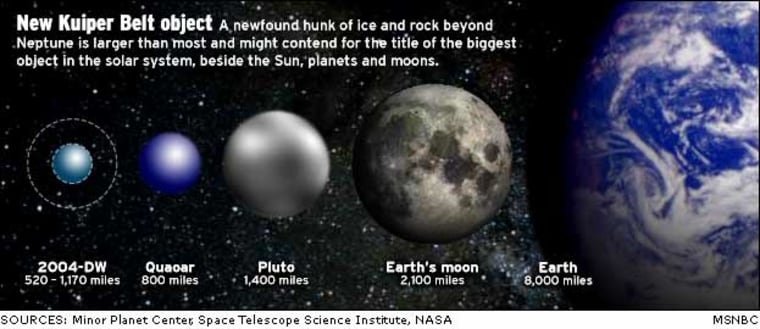A newfound hunk of ice and rock beyond Neptune is larger than most and might contend for the title of the biggest object in the solar system besides the sun, planets and moons.
The object is in a region of frozen, cometlike bodies called the Kuiper Belt. The discovery was announced Thursday by the Minor Planet Center in Cambridge, Mass.
Preliminary observations suggest that the icy rock, labeled 2004 DW, is 520 to 1,170 miles wide (840 to 1,880 kilometers). Physics dictates that objects this large be generally round, like mini-worlds.
The largest known Kuiper Belt Object is called Quaoar (KWAH-o-ar) and was discovered in 2002. Quaoar is roughly 780 miles (1,250 kilometers) wide, about half as big as Pluto. It orbits the sun every 288 years, mostly beyond Pluto's orbit.
More observations will be needed to pin down the size of the newfound object. It may turn out to be much smaller than Quaoar, or it could be bigger.
Researchers estimate the size of these objects by noting their brightness and making assumptions about how much light they reflect. Those assumptions assume a certain level of reflectivity for the surface material.
The discovery was made by the California Institute of Technology's Mike Brown and colleagues Chad Trujillo and David Rabinowitz as part of the same survey that found Quaoar two years ago.
"The object is probably about 1,600 kilometers in diameter, larger than the 1,250-kilometer Quaoar," the researchers said Thursday in a Web posting. "If subsequent measurements verify this size estimate, this would make 2004 DW the largest minor planet known, and larger than Pluto's moon Charon, which is about 1,300 kilometers in diameter. This still doesn't beat Pluto, which is about 2,300 kilometers in diameter."
The finding was confirmed with observations by a team based at the Starkenburg Observatory in Spain and other sightings from the Jet Propulsion Laboratory's Table Mountain Observatory in Southern California.
"It wasn't moving much, so I knew it was way out there," Table Mountain's Jim Young told Space.com. Researchers measure an object's movement against the fairly stable background stars to gauge its distance. "I went home and told my wife, 'That thing's gotta be big.'"
2004 DW is nearly 47 times as far from the sun as Earth is.
Scientists expect more large objects to be found in the Kuiper Belt now that search techniques and technology have been refined. Some astronomers say it's possible that an object larger than Pluto might still lurk there unfound.
An earlier version of this story gave discovery credit to NASA's Near-Earth Asteroid Tracking Program. That program had sent the discovery data to the Minor Planet Center but was not directly involved in the discovery.
